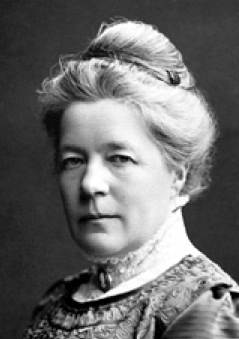Season 5
from april 29th to may 1st, 2011
at 2pm and at 4pm
at the International Antiquarian Book Fair
at the Grand Auditorium of the Grand Palais, Paris
 © Opale
© Opale Selma LAGERLÖF
Nobel Prize 1909
« in appreciation of the lofty idealism, vivid imagination and spiritual perception that characterize her writings. »
Salma Lagerlöf grew up in a remote province of Sweden, the Värmland, populated by supernatural and fantastical creatures. In the manor of Marbacka lived the women, Selma, the servants and the housekeepers, and then the men, among them the father of Selma., an irascible man, incapable of managing his own affairs. The women, concerned with retaining the tranquility of the household did everything possible to appease the father and his bitterness. It would be the women as well who gave Selma the basic education that she would need later when she joined the Royal Pedagogical Institute in Stockholm from 1882 to 1885. Selma found herself therefore the heir to a double culture : the academic culture taught at the institute and an oral culture transmitted by the woman she was surrounded by during the long winter evenings. These women had taught her the art of narrative : the formulae of stories caught the attention of Selma and had an instant effect upon her mind. She saw in her imagination forests and prairies that were filled with magical creatures of all sorts.
Selma employed her talents as a storyteller for the first time in 1885, in front of the school children of Landskrone in Scania. She would retain the role of school teacher for 10 years. From 1895, Selma abandoned teaching and wrote more and more : The Saga of Gösta Berling would soon be published, and would have great success. From 1895 to 1901, Selma went on long trips throughout the Orient with her mother. During this period she wrote volumes on Jerusalem and The Miracles of the Antichrist
These trips symbolised also a period of research and literary experimentation. Lagerlöf was looking for a purer style, that would be unblemished by an excess of pathos and romanticism. Selam was a skilled artist who truly mastered the art of recounting. As her works progressed, her technique became more refined – her limpid prose and the brief structure of her stories profited from the epic and folkloric mix, and the themes asserted themsleves clearly ; such as redemptive love, the woman ready to sacrifice her well being to support the man, touched by a blind strength…Man is also saved from his state of depravation by the tenderness of one or many women. Ultimately everything happens as it did in the childhood of Selma : it is the woman who retains order and peace and saves the man from death. We should not suggest however that the way in which she perceived of men was devoid of tenderness ; on the contrary ; it suffices simply to read the stories and to examine what is happening in the hearts of the heroines to see that the novelist shares her whole heart with men.
In 1906 she wrote The Wonderful Adventures of Nils . In 1909 she won the Nobel Prize. Once she had achieved maturity, Lagerlof, who had already found much success , took the decision to buy the land of her parents in Mabacka and returned to live there. In 1914 came the war, from which she would never recover. In fact the images of the trenches destroyed all hope in her for peace and love. She discovered with the war the reality of an unpitying world that she would describe in the The Exile in 1918 ; the story is a plea for peace. As the years went by and Selma grew old she dedicated herself more and more to poetry and theatre. Towards the end of her life, she devoted herself to novels again ; she would write The Ring of the Löwenskölds II and III which would complete the Löwensköld trilogy. She died in 1940.

